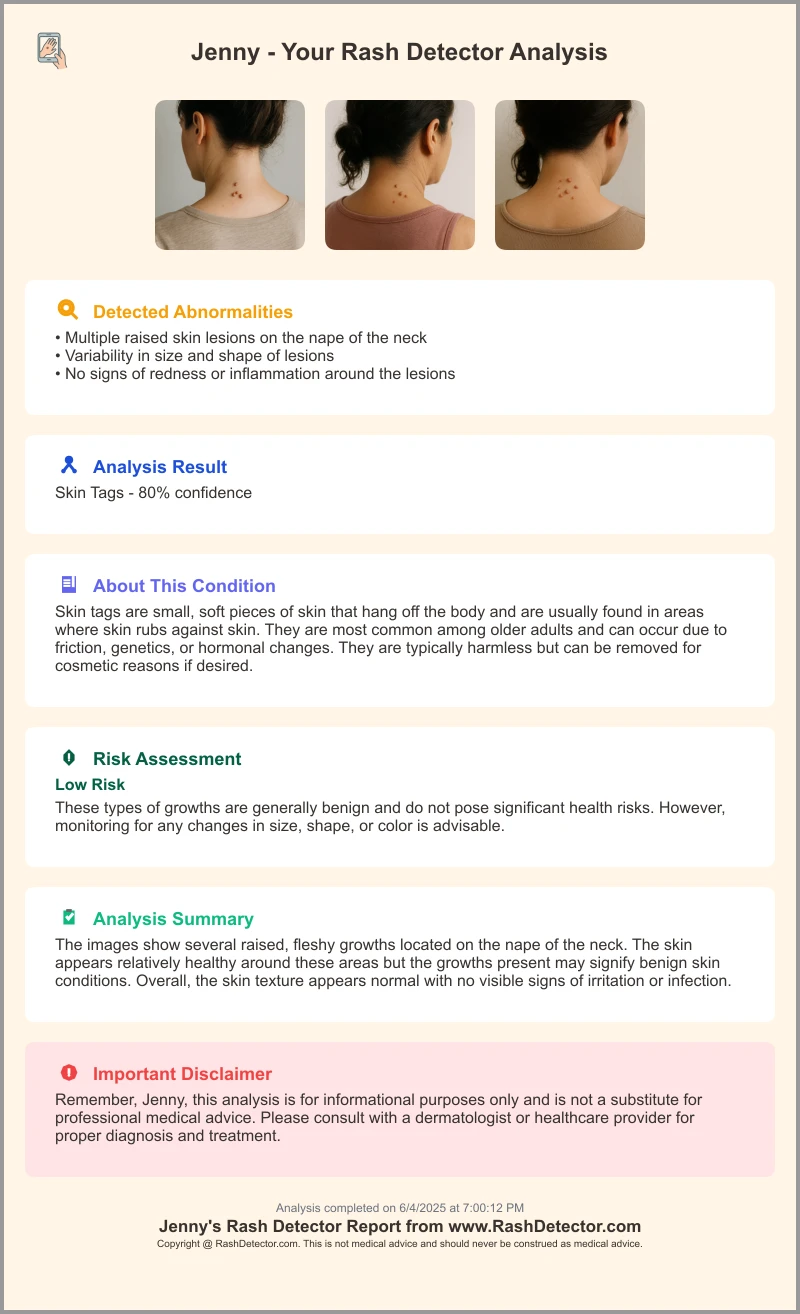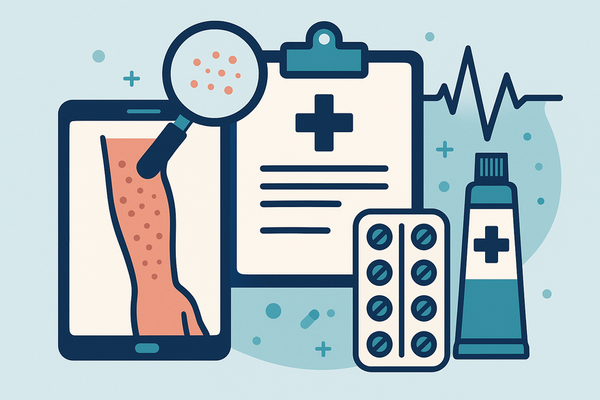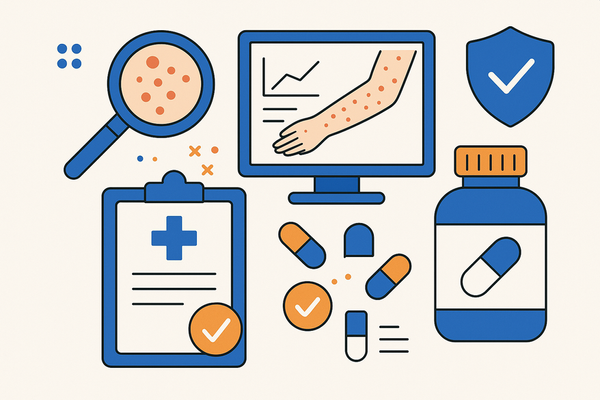Effective Medication Rash Treatment: Identification, Management, and Prevention
Learn how to identify, manage, and prevent medication-induced rashes with effective treatment options to ensure patient safety. Discover evidence-based strategies now.

Estimated reading time: 5 minutes
Key Takeaways
- Understanding causes and types of medication-induced rashes for effective treatment.
- Recognizing symptoms quickly and differentiating from other skin conditions.
- Comparing OTC and prescription options to manage rash severity.
- Implementing prevention strategies to avoid future reactions.
Table of Contents
- Understanding Medication-Induced Rashes
- Identifying a Medication-Induced Rash
- Medication Rash Treatment Options
- Managing and Preventing Future Rashes
- Conclusion
- FAQ
Understanding Medication-Induced Rashes
Definition and Relevance
A medication rash is any visible skin reaction triggered by a drug—either a side effect, allergic response, or interaction. These eruptions can range from mild redness to severe, life-threatening blistering. Effective medication rash treatment begins with understanding why these reactions happen.
Common Causes
- Allergic reactions: penicillins, sulfa drugs, anticonvulsants
- Nonallergic side effects: NSAIDs, certain antibiotics
- Drug–drug interactions: two or more medications that increase skin sensitivity
Types of Medication-Induced Rashes
- Hives (urticaria): raised, itchy welts that move around the body; often signal histamine release
- Morbilliform rash: pink/red maculopapular bumps spreading from trunk to limbs; common with antibiotics
- Fixed drug eruption: singular dark red or purple patch that reappears in the same spot on re-exposure
- Severe reactions: Stevens–Johnson syndrome or toxic epidermal necrolysis, featuring widespread blistering, mucosal involvement, and high risk of fatality
Risk Factors
- Age extremes: children and elderly have higher sensitivity
- Previous allergic history: patients with past drug rashes are at higher risk
- Polypharmacy: combining multiple drugs raises interaction chances
- Genetic predisposition: certain HLA types linked to severe rashes
For a detailed overview of recognizing drug-induced rash symptoms, refer to this guide.
Identifying a Medication-Induced Rash
Common Signs and Symptoms
Redness, itching, or swelling; raised bumps or welts; blistering or peeling in severe cases; systemic signs like fever or joint pain.
Differentiation from Other Skin Conditions
Rash timing linked to drug start or change, presence of systemic signs, and comparison with eczema or contact dermatitis help differentiate medication rashes.
Importance of Medical History Review and Monitoring
Maintain a medication diary with names, dates, and doses. Share full history with all providers and attend regular follow-ups.
To complement manual monitoring and aid in early identification, many users turn to Skin Rash App for instant AI-driven feedback. The app generates a comprehensive summary as shown below:

Medication Rash Treatment Options
Immediate Home-Care Measures for Mild to Moderate Rashes
Discontinue the suspected drug only under medical advice; use cool compresses; apply gentle, soap-free cleansers and hypoallergenic moisturizers.
Criteria for Professional Medical Advice
Seek urgent care for widespread rash, blistering, mucosal involvement, anaphylaxis signs, or systemic symptoms.
Medical Treatments Prescribed by Clinicians
- Antihistamines: Cetirizine or fexofenadine OTC; diphenhydramine for intense itching. Learn more about top OTC options.
- Corticosteroids: Topical hydrocortisone 1%; oral prednisone taper; IV methylprednisolone for severe SJS/TEN.
- Epinephrine auto-injector: For diagnosed or imminent anaphylaxis.
OTC vs. Prescription: Benefits and Risks
OTC treatments are cost-effective and accessible for self-limited rashes; prescription medications are vital for persistent or life-threatening reactions.
Managing and Preventing Future Rashes
Preventive Communication
Inform all providers about drug allergies both verbally and via written records. Keep EHR allergy lists updated.
Reviewing Medication Alternatives
Ask about non-cross-reactive options and consider allergy testing.
Proper Dosing and Adherence
Follow prescriptions exactly; monitor for early symptoms when starting new medications.
Lifestyle and Home-Remedy Adjuncts
Oatmeal baths, cool compresses, breathable cotton clothing, and nail trimming help soothe minor flares. Home remedies support but don’t replace professional care.
Discover expert tips on preventing recurring rashes.
Conclusion
Early identification, evidence-based medication rash treatment steps, and prevention strategies are key to patient safety. “Medication rash treatment” involves knowing the signs, acting promptly with home or clinical measures, and preventing future reactions through clear communication and monitoring. Consult your healthcare professional for personalized advice and ongoing evaluation.
FAQ
- What should I do if I develop a rash after taking medication?
Stop the medication under medical guidance, use cool compresses and gentle moisturizers, and seek professional evaluation if symptoms worsen or systemic signs appear. - How can I differentiate a drug-induced rash from other skin conditions?
Consider the timing of onset after drug initiation, look for systemic symptoms like fever, and compare with previous history of eczema or contact dermatitis. - Are over-the-counter treatments safe for medication-induced rashes?
OTC antihistamines and mild corticosteroids can relieve symptoms in mild cases, but persistent or severe reactions require prescription therapies and specialist care. - Can medication rashes be prevented?
Yes—by informing all healthcare providers of drug allergies, reviewing alternatives, and monitoring new medications closely. - When should I seek emergency medical attention?
If you experience widespread blistering, mucosal involvement, difficulty breathing, or signs of anaphylaxis, call emergency services immediately.





